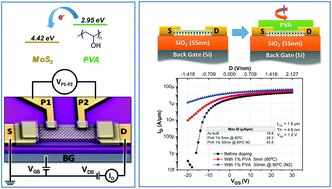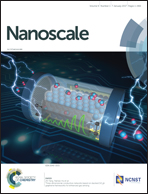Highly efficient and stable MoS2 FETs with reversible n-doping using a dehydrated poly(vinyl-alcohol) coating†
Abstract
Despite rapid progress in 2D molybdenum disulfide (MoS2) research in recent years, MoS2 field-effect transistors (FETs) still suffer from a high metal-to-MoS2 contact resistance and low intrinsic mobility, which are major hindrances to their future application. We report an efficient technique to dope thin-film MoS2 FETs using a poly(vinyl-alcohol) (PVA) polymeric coating. This results in a reduction of the contact resistance by up to 30% as well as a reduction in the channel resistance to 20 kΩ sq−1. Using a dehydration process, we were able to effectively control the surface interactions between MoS2 and the more electropositive hydroxyl groups (–OH) of PVA, which provided a controllable and yet reversible increase in the charge carrier density to a value of 8.0 × 1012 cm−2. The non-covalent, thus non-destructive, PVA doping of MoS2 increases the carrier concentration without degrading the mobility, which shows a monotonic increase while enhancing the doping effect. The PVA doping technique is then exploited to create heavily doped access regions to the intrinsic MoS2 channel, which yields 200% increase of the ON-state source–drain current. This establishes PVA doping as an effective approach to enhance the transport properties of MoS2 FETs for a variety of applications.


 Please wait while we load your content...
Please wait while we load your content...